 VAMPYROS
LESBOS/SHE KILLED IN ECSTASY (1971) Blu-ray
VAMPYROS
LESBOS/SHE KILLED IN ECSTASY (1971) Blu-rayDirector: Jess Franco
Severin Films
 VAMPYROS
LESBOS/SHE KILLED IN ECSTASY (1971) Blu-ray
VAMPYROS
LESBOS/SHE KILLED IN ECSTASY (1971) Blu-rayThe third time's the charm with Severin Film's Blu-ray limited special editions of these two German Jess Franco masterworks showcasing the charms of the late, lamented Soledad Miranda.
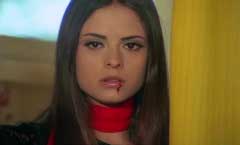
Having broken away from producer Harry Alan Towers after a series of more widely distributed and comparatively mainstream but compromised films with his the ultra low-budget NIGHTMARES COME AT NIGH, DE SADE 70, and the lost SEX CHARADE, Jess Franco discovered his first muse Soledad Miranda (who he had first used in the Towers-produced COUNT DRACULA as Lucy) and followed these up with a production deal with prolific German producer Artur Brauner of CCC Film that netted eight features (out of the thirteen credited as being released between 1971 and 1972). Miranda would only topline three of these before she was killed in a collision with a truck on the Costa del Sol highway just after Brauner offered her a multi-year film contract. Franco's THE DEVIL CAME FROM AKASAVA was one of Brauner's attempts to cash in on the Rialto Edgar Wallace series of films (Franco also did a Mabuse film for him) enlivened only by Miranda's appearances, but VAMPYROS LESBOS and SHE KILLED IN ECSTASY might be regarded as the films that made her a cult icon.
 In
VAMPYROS LESBOS, attorney Linda Westinghouse (Ewa Strömberg, THE COLLEGE
GIRL MURDERS) – who, like many Franco heroines has been "suffering"
from erotic nightmares involving a mysterious stripper (Miranda) – travels
to Istanbul to bequeath the inheritance of Count Dracula's local estate to the
Countess Nadine Carody who lives in a pop-art seaside house on Kandidados Island.
After a nightmarish stay at an inn on the mainland where night clerk Memmet
(Franco himself) likes to break human dolls in the wine cellar, Linda arrives
on the island and meets the countess who she recognizes from her dreams. The
countess makes short work of seducing Linda – over a nude swim and some
particularly red wine – and puts the bite on her. When Linda sees the
blood-gorged floating apparently dead in her swimming pool, she faints and wakes
in the clinic of Dr. Seward (Dennis Price, THE HAUNTED HOUSE OF HORROR) who
is also treating Agra (Heidrun Kussin, THE FORGER OF LONDON), a previous victim
of the countess driven mad when abandoned by the vampire but now serving as
an indicator of her proximity. Seward counsels Linda and her beleaguered fiancé
Omar (Andre Montchal, DE SADE 70) on how to destroy vampires, but the doctor
himself is really interested in crossing over into the world of darkness himself.
In
VAMPYROS LESBOS, attorney Linda Westinghouse (Ewa Strömberg, THE COLLEGE
GIRL MURDERS) – who, like many Franco heroines has been "suffering"
from erotic nightmares involving a mysterious stripper (Miranda) – travels
to Istanbul to bequeath the inheritance of Count Dracula's local estate to the
Countess Nadine Carody who lives in a pop-art seaside house on Kandidados Island.
After a nightmarish stay at an inn on the mainland where night clerk Memmet
(Franco himself) likes to break human dolls in the wine cellar, Linda arrives
on the island and meets the countess who she recognizes from her dreams. The
countess makes short work of seducing Linda – over a nude swim and some
particularly red wine – and puts the bite on her. When Linda sees the
blood-gorged floating apparently dead in her swimming pool, she faints and wakes
in the clinic of Dr. Seward (Dennis Price, THE HAUNTED HOUSE OF HORROR) who
is also treating Agra (Heidrun Kussin, THE FORGER OF LONDON), a previous victim
of the countess driven mad when abandoned by the vampire but now serving as
an indicator of her proximity. Seward counsels Linda and her beleaguered fiancé
Omar (Andre Montchal, DE SADE 70) on how to destroy vampires, but the doctor
himself is really interested in crossing over into the world of darkness himself.

VAMPYROS LESBOS is a loose, experimental telling of "Dracula" (with the lesbian elements drawn more from "Carmilla" than the hints in Universal's DRACULA'S DAUGHTER), the film inverts various elements of the Stoker tale. Instead of a dusty castle, the countess beachside house is strewn with fishing nets and a blood red ceiling hanging suggestive of both webs and stalactites while vampiric bites cut away to shots of a scorpion (which rolls over and dies after the countess is dispatched). Harker and Renfield are female here (although this makes Omar the Mina equivalent but he's fairly useless), and Seward (rather than Van Helsing) is more interested in joining the forces of darkness rather than destroying them. While Agra qualifies as the Renfield equivalent and José Martínez Blanco as the countess' valet Morpho could perhaps be slotted in as the equivalent of the village gypsies in league with the vampire (or just a mute servant along the lines of Franco's other Morphos), Franco's maniac is entirely superfluous. In later Franco films, the institutionalized character of Agra would be a naked nympho like similar bedeviled characters in LORNA THE EXORCIST and DORIANA GRAY. While FEMALE VAMPIRE/EROTIKILL could be seen as a more explicit variation on the lesbian vampire theme, Franco would rework the VAMPYROS LESBOS scenario a number of times in different forms over the years from MACUMBA SEXUAL during his eighties Golden Films period in Spain to VAMPIRE BLUES during his first digital video period to SNAKEWOMAN in 2005. Miranda's countess also inspired the dancer played by Salma Hayek in Robert Rodriguez's FROM DUSK TIL DAWN.
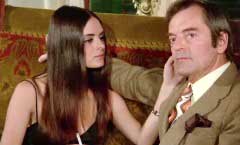 A
variation on THE BRIDE WORE BLACK (which partially inspired Franco's earlier
THE DIABOLICAL DR. Z), SHE KILLED IN ECSTASY finds Mrs. Johnson (Miranda) in
mourning over her husband Dr. Johnson (Fred Williams, COUNT DRACULA) who suffered
a nervous breakdown and committed suicide just two years into their once blissful
marriage after the medical council rejected his human embryo experiments, dismissing
him as immoral, a charlatan, and a criminal and setting out to ruin him both
professionally and legally. Cuddling against her husband's corpse in their seaside
pagoda (Xanadu, designed by Ricardo Bofill, also featured in COUNTESS PERVERSE
and EUGENIE 80), she plots the systematic seduction and destruction of her husband's
killers: Professor Jonathan Walker (Howard Vernon in a character similar to
the one he would play in Walerian Borowczyk's DR. JEKYLL AND HIS WOMEN), Dr.
Crawford (VAMPYROS LESBOS' Ewa Strömberg), Dr. Donen (Jess Franco), and
Dr. Franklin Houston (Paul Muller, A VIRGIN AMONG THE LIVING DEAD) who distanced
himself from Johnson despite wife's pleas for help.
A
variation on THE BRIDE WORE BLACK (which partially inspired Franco's earlier
THE DIABOLICAL DR. Z), SHE KILLED IN ECSTASY finds Mrs. Johnson (Miranda) in
mourning over her husband Dr. Johnson (Fred Williams, COUNT DRACULA) who suffered
a nervous breakdown and committed suicide just two years into their once blissful
marriage after the medical council rejected his human embryo experiments, dismissing
him as immoral, a charlatan, and a criminal and setting out to ruin him both
professionally and legally. Cuddling against her husband's corpse in their seaside
pagoda (Xanadu, designed by Ricardo Bofill, also featured in COUNTESS PERVERSE
and EUGENIE 80), she plots the systematic seduction and destruction of her husband's
killers: Professor Jonathan Walker (Howard Vernon in a character similar to
the one he would play in Walerian Borowczyk's DR. JEKYLL AND HIS WOMEN), Dr.
Crawford (VAMPYROS LESBOS' Ewa Strömberg), Dr. Donen (Jess Franco), and
Dr. Franklin Houston (Paul Muller, A VIRGIN AMONG THE LIVING DEAD) who distanced
himself from Johnson despite wife's pleas for help.
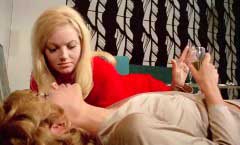
Whereas Jeanne Moreau's titular THE BRIDE WORE BLACK remained an icy figure throughout, SHE KILLED IN ECSTASY plunges us into the emotional world of Mrs. Johnson. Although Franco was probably not involved in the creation of the opening credits (other than photographing the background), the crediting of Miranda and Williams over a shot of conjoined twins in the womb is a nice touch considering how they seem to be two halves of a whole wanting to exist in an insular world (with Mrs. Johnson as the figuratively and then literally warm-blooded half). While the doctor has other passions in his research, all his wife has is him. When Johnson deteriorates and commits suicide, she loses everything (she is not even assigned a first name). The intercutting of her love scenes with her husband with her seduction of the men may be less suggest a craving for lost warmth just as the castration of her victims may not be so gratuitous as an expression of resentment for her husband abandoning her (in the flashback, she does nuzzle his crotch before realizing his disinterest in a shot that seems particularly racy for 1970). The ending is rather slapdash and proves just how superfluous co-production quota hire Horst Tappert (later of the long-running series DERRICK) – as a detective investigating the vandalism of Johnson's lab who suspects the quartet of doctors who are soon seeking his help – is to the story. The Schwab/Hubler tracks – supplemented with additional music from Bruno Nicolai – are not as well-employed here as in the former film.
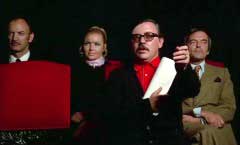 Never
released in the United States (or any other English-speaking territory) theatrically
or on home video, VAMPYROS LESBOS and SHE KILLED IN ECSTASY first became available
over here on subtitled bootlegs from Video Search of Miami (the former being
a composite of the more explicit German version and exclusive footage from the
Spanish cut). The soundtrack CD from the German label Lucertola Media lead to
a resurgence of interest in the films (a 14-track "Vampyros Lesbos Sexadelic
Dance Party" from German label Crippled Dick Hot Wax followed by a wider
release from Motel Room Records followed), especially after Quentin Tarentino
used a track from VAMPYROS LESBOS in JACKIE BROWN. Redemption Films would release
English-subtitled cassettes in the late nineties using 1" PAL masters struck
by rights owner Cine-International for Crippled Dick Hot Wax who released tapes
of the films and other merchandise after the CD's success. When Synapse Films'
Don May decided to release the films on DVD in 1999, he had to contend with
the PAL tape masters – albeit correctly converted to NTSC at the original
film speed – since Cine-International told him the negatives were unusable
(and the prints they sent him were reddish and missing frames). The resulting
non-anamorphic, letterboxed DVDs were more than welcome releases at the time.
Thus, it would come as a surprise when Second Sight released beautiful new 16:9
transfers from the negatives the following year. Image Entertainment acquired
the newer masters in 2004, but examination of the VAMPYROS LESBOS transfer revealed
that framing issues besides the vertical cropping from 1.66:1 to 1.78:1 with
information missing from the right side of the frame (throwing off a number
of compositions with characters on either side of the frame) as well as some
along the bottom.
Never
released in the United States (or any other English-speaking territory) theatrically
or on home video, VAMPYROS LESBOS and SHE KILLED IN ECSTASY first became available
over here on subtitled bootlegs from Video Search of Miami (the former being
a composite of the more explicit German version and exclusive footage from the
Spanish cut). The soundtrack CD from the German label Lucertola Media lead to
a resurgence of interest in the films (a 14-track "Vampyros Lesbos Sexadelic
Dance Party" from German label Crippled Dick Hot Wax followed by a wider
release from Motel Room Records followed), especially after Quentin Tarentino
used a track from VAMPYROS LESBOS in JACKIE BROWN. Redemption Films would release
English-subtitled cassettes in the late nineties using 1" PAL masters struck
by rights owner Cine-International for Crippled Dick Hot Wax who released tapes
of the films and other merchandise after the CD's success. When Synapse Films'
Don May decided to release the films on DVD in 1999, he had to contend with
the PAL tape masters – albeit correctly converted to NTSC at the original
film speed – since Cine-International told him the negatives were unusable
(and the prints they sent him were reddish and missing frames). The resulting
non-anamorphic, letterboxed DVDs were more than welcome releases at the time.
Thus, it would come as a surprise when Second Sight released beautiful new 16:9
transfers from the negatives the following year. Image Entertainment acquired
the newer masters in 2004, but examination of the VAMPYROS LESBOS transfer revealed
that framing issues besides the vertical cropping from 1.66:1 to 1.78:1 with
information missing from the right side of the frame (throwing off a number
of compositions with characters on either side of the frame) as well as some
along the bottom.
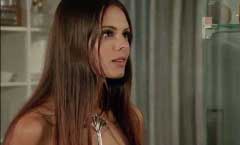
Severin's Blu-ray editions follow on the heels of the 2014 Region B German/Swiss/Austrian Blu-ray from Illusions Unlimited, and the first thing evident in the new 1080p24 MPEG-4 AVC 1.66:1 transfer of VAMPYROS LESBOS – once again using the French source – are the reds which pop in every shot – including scenes where the countess wears a red scarf that hangs down her body like blood from a fresh throat wound – as well as the subtle gel lighting during the striptease scenes. It does, however, reveal fading along the right side (which was probably the reason that the previous 16:9 master cropped that side), but the colors are mostly stable and the framing is more meticulously composed than we have come to expect from some of the more rushed Franco productions to come. The uncompressed LPCM 2.0 mono audio is clean and has a dimensional presence that draws attention to the marriage of sound and image that is not quite as literal as it was on the Towers films but not quite as loose as in later Franco films. Although the optional English subtitles do reveal how dependent we are dialogue for the back-story, we do not necessarily need dialogue in the film at all to experience if we do not care about the countess' relationship to Dracula.
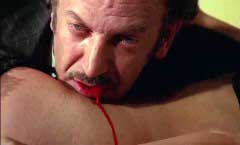 SHE
KILLED IN ECSTASY – also framed at 1.66:1 – is also a gorgeous experience,
with lush lavenders the dominant color of Miranda's wardrobe (although reds
when they appear are just as vibrant as on the other film). There are a few
areas of damage to the picture but they are non-disruptive. The LPCM 2.0 mono
audio, on the other hand, is strong but there are passages of hiss and crackling.
One bit of patched-up audio has an echo that suggests that the restoration technicians
left the both the track with the master's original audio and the track with
the audio from another source both enabled. While an obvious mistake, it does
create a sense of delirium in a scene that at first suggests a stalking of Dr.
Houston by Mrs. Johnson that is revealed to be an unplanned encounter. The fact
that the notes left by Mrs. Johnson on her victims are in English suggests an
intention to release the film in English-speaking countries which never happened
(as far as I know, no English dub for either film was ever created). This version
runs three minutes longer than the previous Synapse and Image discs (the latter
a PAL-NTSC conversion but the former had a 24fps running time of 77:08) which
restores two bloody full-frontal of Walker's death, additions shots of Crawford
struggling with Mrs. Johnson, additional shots to Huston's death (including
some furious topless stabbing) – whose method of death recalls Lorna's
killing method in SUCCUBUS – some additional shots of Mrs. Johnson caressing
her husband's corpse and straddling it, and additional shots to her furious
stabbing of Donen. Some of this material must have been censored from the German
version (because of their preference for sex over violence) and its recovery
is stunning.
SHE
KILLED IN ECSTASY – also framed at 1.66:1 – is also a gorgeous experience,
with lush lavenders the dominant color of Miranda's wardrobe (although reds
when they appear are just as vibrant as on the other film). There are a few
areas of damage to the picture but they are non-disruptive. The LPCM 2.0 mono
audio, on the other hand, is strong but there are passages of hiss and crackling.
One bit of patched-up audio has an echo that suggests that the restoration technicians
left the both the track with the master's original audio and the track with
the audio from another source both enabled. While an obvious mistake, it does
create a sense of delirium in a scene that at first suggests a stalking of Dr.
Houston by Mrs. Johnson that is revealed to be an unplanned encounter. The fact
that the notes left by Mrs. Johnson on her victims are in English suggests an
intention to release the film in English-speaking countries which never happened
(as far as I know, no English dub for either film was ever created). This version
runs three minutes longer than the previous Synapse and Image discs (the latter
a PAL-NTSC conversion but the former had a 24fps running time of 77:08) which
restores two bloody full-frontal of Walker's death, additions shots of Crawford
struggling with Mrs. Johnson, additional shots to Huston's death (including
some furious topless stabbing) – whose method of death recalls Lorna's
killing method in SUCCUBUS – some additional shots of Mrs. Johnson caressing
her husband's corpse and straddling it, and additional shots to her furious
stabbing of Donen. Some of this material must have been censored from the German
version (because of their preference for sex over violence) and its recovery
is stunning.

Both films include interviews with Franco. For VAMPYROS LESBOS, "Interlude in Lesbos" (20:50) in which he discusses how he and Brauner planned to build up Miranda in a series of increasingly higher-budgeted and important movies starting with VAMPYROS LESBOS and leading up to an adaptation of Alexander Pushkin's "The Station Master" (previously adapted in Germany as DER POSTMEISTER). He also discusses the importance of German expressionism in all cinema (including British cinema which should not have been influenced by it by principle). He also discusses his love of vampire films and the lesbian aspect (he praises BLOOD AND ROSES as elegant but did not like it overall). He also expresses his preference for Kussin who came from the communist bloc of East Germany over Stromberg who he found to be difficult as an actress.
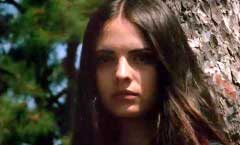 In
"Sublime Soledad " (20:26), Miranda historian Amy Brown discusses
the actress' beginnings supporting her parents and five younger siblings with
professional flamenco dancing from a young age. She discusses Miranda's pre-Franco
filmography which included twenty-five films (including a blink and you'll miss
it cameo in Franco's musical LA REINA DEL TABARIN that she got as a roommate
to its star Mikaela Wood) including the horror outings PYRO and THE SOUND OF
HORROR before retiring in 1967 when she married and had a son (especially after
her role in CERVANTES had been cut down supposedly at the behest of star Gina
Lollibrigida who reportedly disliked her). She returned to acting when offered
a role in the Burt Reynolds' starrer 100 RIFLES. Brown glosses over the details
of the Franco films – nothing that Christopher Lee on COUNT DRACULA expressed
skepticism about casting an "Andalusian gypsy" as Lucy until he met
her in person and she subsequently won his praise as an actress – but
does discuss how the more expressive roles allowed her to expand her range compared
to the bland comedies and melodramas in which she was typecast during her Spanish
career.
In
"Sublime Soledad " (20:26), Miranda historian Amy Brown discusses
the actress' beginnings supporting her parents and five younger siblings with
professional flamenco dancing from a young age. She discusses Miranda's pre-Franco
filmography which included twenty-five films (including a blink and you'll miss
it cameo in Franco's musical LA REINA DEL TABARIN that she got as a roommate
to its star Mikaela Wood) including the horror outings PYRO and THE SOUND OF
HORROR before retiring in 1967 when she married and had a son (especially after
her role in CERVANTES had been cut down supposedly at the behest of star Gina
Lollibrigida who reportedly disliked her). She returned to acting when offered
a role in the Burt Reynolds' starrer 100 RIFLES. Brown glosses over the details
of the Franco films – nothing that Christopher Lee on COUNT DRACULA expressed
skepticism about casting an "Andalusian gypsy" as Lucy until he met
her in person and she subsequently won his praise as an actress – but
does discuss how the more expressive roles allowed her to expand her range compared
to the bland comedies and melodramas in which she was typecast during her Spanish
career.

Franco scholar Stephen Thrower (11:24) provides a brief appreciation in which he discusses Franco's taste of freedom from Towers with the three self-financed Eurocine pick-ups, VAMPYROS LESBOS' visual abstraction and the ways in which the Spanish version tried to make sense of it. In the "Jess is Yoda" clip (2:42), Franco vaguely discusses his working relationship with effects artist Stuart Freeborn – they share no credits in common on IMDb, but Freeborn may have worked on the Towers films – and how Freeborn told him that he based the features of Yoda on him. Besides the German theatrical trailer (2:27), the German opening title sequence (1:26) is also included. The content of the credits is the same but the title is subtitled "Dracula's Heiress" and ends with a quotation from Heinrich Heine's poem "Helena".
 Besides
the "Sublime Soledad" featurette ported over from the co-feature,
SHE KILLED IN ECSTASY also features "Jess Killed in Ecstasy " (16:55)
in which Franco cites the origins of the film not in the Truffaut film or the
Cornell Woolrich novel but in a story by Gabriel Marcel. He discusses the actors
including Williams who he thought did well enough but was not compelling enough
of an actor to embody the other half of the couple to justify the wife's obsessive
love and vengeance. He explains Miranda's billing as Susann Korda as Brauner
wanted a more international sounding name than a Spanish one, and that Franco
suggested Korda after filmmaker Alexander Korda. There is some overlap with
the VAMPYROS LESBOS interview as he discusses Brauner's proposed multi-film
contract and her death, but he becomes more emotional here while discussing
it.
Besides
the "Sublime Soledad" featurette ported over from the co-feature,
SHE KILLED IN ECSTASY also features "Jess Killed in Ecstasy " (16:55)
in which Franco cites the origins of the film not in the Truffaut film or the
Cornell Woolrich novel but in a story by Gabriel Marcel. He discusses the actors
including Williams who he thought did well enough but was not compelling enough
of an actor to embody the other half of the couple to justify the wife's obsessive
love and vengeance. He explains Miranda's billing as Susann Korda as Brauner
wanted a more international sounding name than a Spanish one, and that Franco
suggested Korda after filmmaker Alexander Korda. There is some overlap with
the VAMPYROS LESBOS interview as he discusses Brauner's proposed multi-film
contract and her death, but he becomes more emotional here while discussing
it.

Stephen Thrower (13:05) appears again to discuss the film as the beginning of his period where Franco became more prolific, constantly shooting and increasingly leaving the post-production to others. He discusses the film's relation to DIABOLICAL DR. Z, how the film feels more thrown-together than VAMPYROS LESBOS, and the shifting of elements from the earlier film, and Franco's central role in the film (which Thrower believes was entirely motivated by the torture/death scene). He spends the latter half discussing Miranda and how she compared to the other actresses Franco was working with at the time (noting his extreme displeasure with Romina Power on JUSTINE). Most welcome is a brief interview with Swiss actor Paul Muller (6:31) – still going strong at ninety-two – speaking in Italian, recalls working with Franco often without a script and Franco shouting direction from behind the camera, and how he agreed to work with Franco whenever he was free rather than setting up contracts and schedules of films. Franco would call various regular producers and whoever gave him money would determine where they would travel to shoot. He describes the experience of working with Franco as pleasant and that he knew no other work was going to get done for the day when Franco was shooting a sex scene. He warmly recalls Miranda as well as Lina Romay (who he says they always called "Dracula" on set for some reason). The disc concludes with the film's German theatrical trailer (2:35).
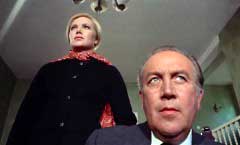 Neither
of these releases are combos (DVD editions will be released separately, but
we have not information on which extras will be carried over). The DVD in the
VAMPYROS LESBOS set carries the film's Spanish cut LAS VAMPIRAS – awkwardly
translated as "The Vampiresses" rather than "The Vampire Women"
– from a bootleg video source supplied by Trash Palace (the Spanish DVD
simply marries the Spanish credits to the older German master). Opening with
male narration, it turns Nadine Carody into Nadia of Oskudar, a princess sentenced
to death by starvation by her husband in a palace on the hill. When her slaves
weakened and died instead of her, the locals believed her to be a vampire (Dracula
saves her from her death sentence rather than from rape and murder). Linda becomes
Alice, and the added narration by her attempts to explain the symbolism of the
scorpion, the kite, and the butterfly. When Dr. Steiner hears of her dream,
he instructs her to devote herself to the man she loves rather than to take
a new lover. The striptease acts are deleted entirely, but one nightclub scene
is replaced with a leather-clad, gum-smacking Miranda weaving around some musicians.
Some of the other additional footage includes a shot of Miranda heading to the
mainland alone on a boat (the shot of her sleeping in the pool is cut) as well
as Memmet warning Alice that people who go to the island do not come back alive.
Neither
of these releases are combos (DVD editions will be released separately, but
we have not information on which extras will be carried over). The DVD in the
VAMPYROS LESBOS set carries the film's Spanish cut LAS VAMPIRAS – awkwardly
translated as "The Vampiresses" rather than "The Vampire Women"
– from a bootleg video source supplied by Trash Palace (the Spanish DVD
simply marries the Spanish credits to the older German master). Opening with
male narration, it turns Nadine Carody into Nadia of Oskudar, a princess sentenced
to death by starvation by her husband in a palace on the hill. When her slaves
weakened and died instead of her, the locals believed her to be a vampire (Dracula
saves her from her death sentence rather than from rape and murder). Linda becomes
Alice, and the added narration by her attempts to explain the symbolism of the
scorpion, the kite, and the butterfly. When Dr. Steiner hears of her dream,
he instructs her to devote herself to the man she loves rather than to take
a new lover. The striptease acts are deleted entirely, but one nightclub scene
is replaced with a leather-clad, gum-smacking Miranda weaving around some musicians.
Some of the other additional footage includes a shot of Miranda heading to the
mainland alone on a boat (the shot of her sleeping in the pool is cut) as well
as Memmet warning Alice that people who go to the island do not come back alive.
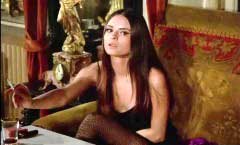 Most
of the Hubler/Schwab score is missing and replaced with music by Franco and
Bruno Nicolai (Thrower compares it to the AWFUL DR. ORLOFF score, but it also
resembles some of the jangling incidental cues of A VIRGIN AMONG THE LIVING
DEAD). Quality is awful in the single-layer, non-anamorphic digitization (mostly
framed at 1.66:1 with a couple unmatted exterior shots) but it is a welcome
extra with subtitles. The CD on SHE KILLED IN ECSTASY is a reproduction of the
Lucertola Media 24-track compilation of tracks from VAMPYROS LESBOS, SHE KILLED
IN ECSTASY, and THE DEVIL CAME FROM AKASAVA in wonderful stereo that makes one
wish a stereo remix of the films were possible. Both sets are handsomely housed
in thick Criterion-style cases (also used by Grindhouse) and slipcovers with
windows that reveal just enough of the portraits of Miranda that adorn each
inner cover. (Eric
Cotenas)
Most
of the Hubler/Schwab score is missing and replaced with music by Franco and
Bruno Nicolai (Thrower compares it to the AWFUL DR. ORLOFF score, but it also
resembles some of the jangling incidental cues of A VIRGIN AMONG THE LIVING
DEAD). Quality is awful in the single-layer, non-anamorphic digitization (mostly
framed at 1.66:1 with a couple unmatted exterior shots) but it is a welcome
extra with subtitles. The CD on SHE KILLED IN ECSTASY is a reproduction of the
Lucertola Media 24-track compilation of tracks from VAMPYROS LESBOS, SHE KILLED
IN ECSTASY, and THE DEVIL CAME FROM AKASAVA in wonderful stereo that makes one
wish a stereo remix of the films were possible. Both sets are handsomely housed
in thick Criterion-style cases (also used by Grindhouse) and slipcovers with
windows that reveal just enough of the portraits of Miranda that adorn each
inner cover. (Eric
Cotenas)